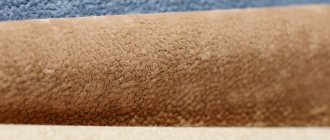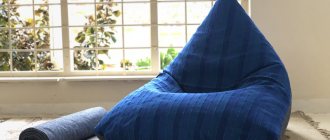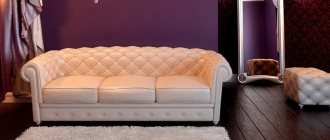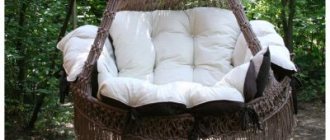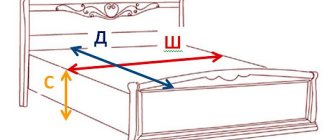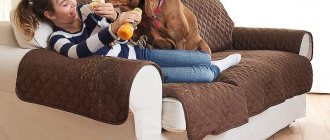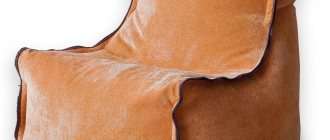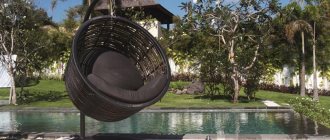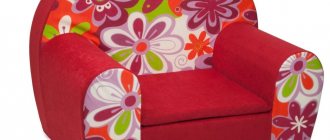Tips for choosing
In order not to be disappointed in your purchase, before going to the store, decide on the following characteristics:
- Textile. Select based on the conditions of use. Study the most common materials and choose the option that suits the characteristics.
- Color. Decide on colors based on the overall style of the room. Remember that light-colored covers quickly become dirty and therefore require frequent washing. Give preference to a dense product that will retain its structure after many washes.
- Style. Directly depends on the type of structure. Find out if there are ready-made cases for your model.
- Dimensions. The cover must fit the dimensions of your sofa. Check which dimensions are required for the selected model.
The variety of types, styles, shapes and sizes of cases is completely confusing. Therefore, take advantage of some secrets of buying them:
A non-stretch regular cover requires knowledge of the exact dimensions of the furniture. Check with sellers for the required dimensions and double check them before purchasing. Custom cases are certainly quite expensive. However, this is a way to get a completely unique item that meets all practical and aesthetic requirements. Eurocase is the simplest and most convenient option. Easy to put on and take off, does not require special care
There is a wide range of this type of cover available for sale. When purchasing, pay attention to the weakest points of the product, namely: the quality of fittings and fastenings. This will help you immediately recognize a fake. Do not make a final purchasing decision without checking the quality of the seams, the integrity of the fabric, and the absence of defects. Remember, the more decorative elements, the more likely they are to fall off. In addition, a simple product is easier to care for. Read the instructions
There are covers made from fabrics that require special care. Sometimes covers are sold with ready-made accompanying products that match in style - bolsters, tablecloths, decorative pillows and napkins.
In addition, a simple product is easier to care for. Read the instructions. There are covers made from fabrics that require special care. Sometimes covers are sold with ready-made accompanying products that match in style - bolsters, tablecloths, decorative pillows and napkins.
Armrests: design options
Sofas with armrests can still be found much more often than their opposite, and besides, they are more traditional in the interior of the room.
They are usually divided into two types:
Sofas with soft armrests are the most practical due to the absence of sharp elements. For their manufacture, as a rule, foam rubber is used.
Sofas with wooden armrests are also quite popular; they have neither upholstery nor fillings. The surface can be matte or glossy, but in any case it should be in harmony with the overall style of the room and not merge with other objects.
From experience of use, the following advantages have been identified:
- wide and durable surfaces can accommodate any dishes, television remote control and similar items;
- they are more durable and resistant to impact during operation;
- it is no secret that natural wood is an environmentally friendly material that will not harm the health of the inhabitants of the house;
- the surfaces are unpretentious in maintenance, as they can be easily cleaned from dust and dirt without purchasing any special cleaning agents or detergents. That is, it is enough to wipe it with a napkin soaked in a soap solution.
We will reveal it locally
Cutting a sofa cover locally is technologically simpler than sewing a dress cover without a pattern, and developing patterns for the cover, and is also quite economical: up to 25% of the cutting area is wasted, depending on the thickness of the seat and backrest. This method is suitable for simple shaped sofas.
With the opening in place, the trace is sewn. sofa covers:
- Covers for geometrically simple, non-folding sofas without armrests, common in modern style interiors, and for book sofas, see below.
- Linings (case covers) made of technical fabric for dress covers sewn without a pattern, so as not to bother with the pattern of the cover case.
- Everyday saving covers (item 3 in the figure), incl. on the sofa in a formal cover.
How to sew a sofa cover with cutting in place is shown in pos. 1 and 2 pictures:
Sewing a sofa cover with cutting to place
Recommendations to reinforce the seams with wooden inserts are most likely either an unqualified translation of the original source, or simply an intuitive guess. In fact, using suitable pieces of wood, folds are formed to reinforce the seams with a turn, see above. If the pieces of wood are left in the seams, they will soon rub through both the cover and the upholstery of the sofa. At pos. 4 gives examples of how to decoratively decorate the covers of the wings of the cover on the armrests; Of course, your own solutions are also possible. If covers are required only for armrests, they are designed in a similar way; In this case, fabric waste is zero or almost zero.
About the role of the case cover
The undercover, firstly, improves the adhesion of the cover made of beautiful but slippery fabric to the sofa. In this case, it is sewn from thin cotton fabric, for example, linen. Old yellowed sheets are perfect; a slipcover made from them holds the satin cover on the faux leather sofa as if sewn on.
Another purpose of the cover is to protect the sofa itself from dirt and grease. If the sofa is leather, this is very important. In this case, the undercover is sewn in 3 layers: a fairly dense technical fabric (linen canvas, matting; you can use propylene from bags) is placed on the upholstery of the sofa, followed by a layer of padding polyester or, better yet, holofiber, and the cover holds the canvas, as in the previous one. case.
For a book
Thanks to Ikea, everyone now knows what a Eurobook sofa is, see figure:
Construction of a Eurobook sofa
It is not said as a reproach: book sofas are indeed very comfortable, and in small one- or two-room apartments they are sometimes irreplaceable. It is only necessary to note that sofa beds of exactly the same design were produced in the USSR back when not every average person in Europe had heard of the embryo of the EU in the form of Benelux. True, sofa sofas were supplied to furniture stores in single copies, which had a small factory defect. Conditional ones were distributed at the top according to orders or were bought up through connections by those admitted to the hairy hands of the Ivan Ivanovichs. According to rumors, just such a sofa bed stood in the Dnepropetrovsk (in his hometown) apartment of the most Ivan Ivanovich of all Ivan Ivanovichs - the unforgettable Leonid Ilyich. Quite plausible: he was a simple and good man, only weak for his post. This is probably why they chose him when the bald clown in power turned out to be no better than the mustachioed monster. But let's get back to the topic.
You need at least 2 separate covers for a sofa book, or 3 if you want the folded back to not stand out in color. You may also need to cover the armrests; then you will need 4 or 5 separate covers. Covers for the armrests of a book sofa are cut in place, as described above, but with one condition: at the bottom, under the underside of the armrests, they must be tightly fastened with a zipper with large teeth, otherwise the mechanism will always be tighten and soon break; The option with a rubber band does not help with this. In fact, covers for the armrests of book sofas are their sore spot, which, as far as we know, has not yet been cured by anyone.
There are no problems with covers for the mattresses of the sofa-book. The pattern is given on the left in Fig. with sizes for popular models:
How to sew a cover for a sofa book
How the corners are stitched is shown in the center. The cover of the book sofa is tightened with an elastic band (on the right in the figure), but first you need to mark the armhole in place along the mechanism. It is a simple straight cut for the boss that fits into the cutout of the lever and is edged with trouser braid; Bias tape wears out soon. The armhole is pulled together from the bottom with an elastic band. To put on or take off the cover, you will first need to remove the linkage; this is done simply by hand without tools, see the instructions for the sofas.
Constructing a pattern
A cover for a chair is cut and sewn in generally the same way as for a sofa. But the different geometric proportions of the chair and the procedure for using it place increased demands on the accuracy of taking patterns from life and cutting fabric. If, for example, you take a pattern for a sofa cover from the same set, throw out the middle of it and sew a chair cover from the rest, then it will almost certainly wrinkle in plain sight, see fig. on right.
Wrinkles on seat covers due to improper cutting
What parts does the pattern of a tight-fitting chair cover consist of, is shown in the figure:
Scheme for constructing a pattern for a chair cover
By widening the back, armrests and front from below, we get a pattern for a cover with flares or a skirt. If you need a semi-loose cut cover, the overhangs of the armrest parts are made straight. For an example, see a selection of videos on how to cut and sew a cover with frills for an armchair:
An example is a good thing, but if you need your own original cover for your own chair, not the same as in the example, and you like a different fabric, then you need to keep something else in mind. In Fig. Above, you can already see the differences between the pattern of a cover for a chair and that for a sofa: the cuts for the front, seat, back and back of the back are elongated in length/height, while for the sofa, on the contrary, in width. The cut for the back of the sofa is also elongated in width, but here it needs to be almost square. If the fabric stretched exactly the same in all directions, it would mean nothing. But it stretches differently along and across. And in a chair cover, the armrests pull the seat more strongly, and its area of contact with the base is smaller.
How to thread a piece of thread and take measurements to create patterns for a chair cover
The first thing that follows from this is that the threads of the cover fabric must be threaded as shown on the left in the figure:
- Facade, seat, back - along the top, deep, up, down.
- Armrests - up and down across.
- Front inserts of straight armrests are vertical.
- Inserts for armrests with camber – give the lobar ones a camber of approx. 1/3 along the top from the greatest extension of the armrest.
That is, cutting the fabric for a chair cover at random, just to save money, will not work - there will be irremovable wrinkles on the finished cover. It is necessary to remove the patterns from the chair, mark the orientation of the lobes on each one, lay them out on the floor in a strip equal to the width of the cut of the chosen fabric and minimize waste, observing the necessary orientation of the lobes. Then the required cut length is measured locally and purchased.
How to remove patterns
For patterns you need to prepare or purchase suitable material, see below. Then the chair is measured, as shown in the center in the figure, and according to the measurements, blank pieces of approximately the same shape are cut out from the pattern material with an allowance of 10-15 cm. The blanks are placed in place, pulled up, crimped at the joints and the contours are drawn with a marker; the orientation of the lobar is immediately noted. After this, the blanks are cut along the contour with an indentation of 7-10 cm and laid out to determine the length of the cut, see above.
Insertion is a delicate matter
If the chair has a large camber of armrests, and the fabric of the cover is chosen to be dense and not very stretchy (jacquard or flock, for example), then the patterns for the inserts in the armrests should not be removed by drawing them in place, but built according to size. Building on a regular grid is tedious and inaccurate - you will almost certainly get lost. Building on an arbitrary grid of basic verticals and horizontals will also take time, but the probability of error is much less and the accuracy is higher. You just need to make a device in addition to the tailor's meter - a simple caliper from a pair of wooden rulers with holes; the length of the rulers is from 30 cm. The ends of the rulers opposite to the holes are cut at an angle of 30-45 degrees towards each other, i.e. mirrored, and the rulers are fastened through the hole with a bolt and nut. The measurement procedure is as follows (see also on the right in the figure):
- Prepare a simple plumb line from some kind of weight and thread or fishing line;
- In nature, along a plumb line, using chalk or soap, mark the base vertical A from the middle of the base of the insert;
- In the same way, mark the base vertical B from the pole of the armrest P - its highest point;
- The main horizontal line is drawn on the template sheet;
- Measure hA - height A from the line of the curb of the chair;
- Construct a basic vertical A on the workpiece;
- On location, measure the distance between the basic verticals C;
- On location, measure the full height of the base vertical B from P to the curb line, and the height of the dip B - hB;
- Based on the data obtained, a basic vertical B is built on the workpiece;
- On location, the arms of the horizontal lines A0 – a(n) are removed using calipers and transferred to the workpiece. The horizontals are placed more often, the steeper the bend of the sides of the insert contour in a given section and the closer they (horizontals) are to the pole. The heights of the horizontal lines are measured with a meter;
- Similarly, the arms of the horizontal lines B0 – b(n) are removed and transferred to the workpiece, but the measurements are taken downwards from the pole;
- Using a regular drawing pattern or by hand, draw the outline of the insert on the workpiece.
The highlight of this method is that in the most critical places, where wrinkles can appear on the product, the shoulders a(n) and b(n) duplicate each other to some extent. Suddenly, when drawing, it turns out that their end marks have diverged greatly; measurements at this level can be repeated, because an error in beating any pair of horizontal arms is not transmitted to the others.
What to make patterns from
The material for the patterns for the chair cover should stretch approx. just like upholstery fabric, and apply it in place, wrinkled in the same way. Then you will immediately see where the cuts for darts are needed or, if there are more than 2-3 of them, where this part needs to be divided into two.
In professional tailoring, pattern pieces are cut out of percale - fabric that has been decatified 3-4 times and impregnated with a special composition. Decorate the canvas by soaking it overnight in initially hot water, drying it and ironing it until dry while still wet. Percale is sold in specialized sewing stores, but in small towns this is most likely not available. You can, of course, order it on the Internet, but if you only need a cover for one chair, you can also wash and starch an old, washed sheet - it has already been dried naturally. However, such a pattern will be disposable: the starch will soon be knocked out, and there is no point in starching again - the dimensions will float away. In most cases, if the chair is not particularly pretentious in shape, percale can be replaced with building insulating material - glassine. You can find it in any hardware store, or they can bring you a custom-made cut from the warehouse. Using glassine patterns, you can cut out covers for 5-6 chairs, which is more than enough for yourself.
Basting a blank pattern for a chair cover made of sheet insulating material
If the cover is insulated, then instead of a pattern you can use the insulation itself - thick sheet polyester, artificial felt, etc. Insulation blanks are applied in place. Working seams are basted with a thick thread, and basting seams for cuts are sewn with a thinner thread of a contrasting color, see fig. on right; The stitching and cutting lines are marked with a marker. In this case, when cutting, you need to add the thickness of the insulation to the sewing allowance.
Sets
Most sofas and armchairs have standard sizes, so manufacturers offer covers whose main feature is versatility. To ensure a perfect fit on chairs of any shape, an elastic band is used.
Today, there are not only covers for office chairs on sale, but also a large assortment of sets designed for entire sets of upholstered furniture. Most often, the set includes a sofa cover and covers for 2 chairs.
The flounces sewn to the bottom of the cape are ideal for furniture with or without legs. A stylish hand-sewn “skirt” will organically fit into any traditional interior. In modern high-tech, loft or minimalist styles, it is better to use more strict and laconic forms.
The upholstery on chairs wears out much faster than on sofas or armchairs. With the help of a new cover, you can quickly turn an old kitchen chair into a bright element of the interior. An excellent solution could be to purchase several tension sets for furniture at once.
Buy a casual set for office chairs or chairs for daily use and a luxurious holiday option for entertaining important guests. For the summer, it is better to choose products made from thin cotton materials; in cold weather, you need cozy soft covers made of faux fur, velor or beautiful crocheted woolen products.
Plaid bedspread made of synthetics
Synthetic bedspreads are currently very popular, these include acrylic, fleece, viscose, and faux fur.
- Acrylic ones are easy to recognize by their catchy colors and low prices; they are soft to the touch and do not pill. This is a comfortable blanket for a bed or chair. Acrylic is the best option for blankets with a logo, as it stains well, and the applied image remains strong and long-lasting. But there is a significant drawback: it does not absorb moisture well, so you should not use it as a blanket.
- Fleece bedspreads are soft, warm and thin, the material is polyester. These products are somewhat more expensive than acrylic ones, but their hygroscopicity is good. Therefore, if you wish, you can sometimes cover yourself with such a blanket, but it is not recommended to sleep under it all the time.
- The product, made from chenille or viscose, has bright colors and a glossy, iridescent texture; the price is the same as the previous one. It is more often used as an interior blanket for a bed and a chair, but it is true that it wears out quickly.
- Faux fur is very popular these days; bedspreads made from it are soft, wear-resistant and add a touch of luxury to the decor. Their cost is slightly higher than that of other synthetic products. A significant drawback of this material is its ability to become highly electrified and accumulate dust. However, this is typical for many synthetic products.
Sewing stages
This section contains step-by-step instructions on how to sew a chair cover with your own hands. It will be useful for both beginners and experienced needlewomen. Furniture can have different configurations, so to sew a cape in each individual case, you need to take measurements of all its elements. Patterns for sewing a chair cover are also required. They are drawn by the craftswoman herself in accordance with the measurements received.
Pattern creation and cutting
It is necessary to measure all parts of the chair: the back, armrests, seat and cushion. First you need to determine where the seams will be. They can be marked directly on the rough fabric. If the cover has a design different from the shape of the furniture, then the seams need to be drawn directly on the upholstery, so that they can then be transferred to the material. At this stage, you need to take into account the inserts for contour alignment, bends, and thickness.
In order not to confuse the sizes, you can write them on the wrong side of the cut parts. When cutting, you need to take into account the darts that allow the cover to fit perfectly around the chair without any bumps. Don’t forget about tucks, folds, frills and hems.
A simple pattern for a chair cover with armrests is made so that, in addition to the seam allowances, there is still 20 cm of fabric left for adjusting the product, bends and overlaps. If some pieces of furniture have an unusual shape, then the pattern is drawn like this: a thin fabric is applied to the fragment and crimped on all sides. After the measurements have been made, you need to make patterns on graph paper. Next, the patterns are laid out on the material so that as little waste as possible remains. The patterns need to be outlined with chalk or pencil, taking into account the allowances.
Measure the chair
Make a pattern
Cut out the details on the fabric
Iron the cut pieces
Pattern option for a simple case
Fit
For the armrests you need to make 2 patterns: outer and inner. Both fragments should be sewn together. In this case, the fabric is folded in half, and seam lines and grain threads are drawn onto it with a pencil.
To fit the resulting patterns, you need to attach them to the chair and pin them with pins. In this case, all folds are tucked in, and seam lines are marked on the material. All excess fabric fragments must be eliminated and darts formed.
Since there will be tucks on the armrests, you need to wrap them on the outside under the curve. There will be a lot of excess fabric in this place that needs to be cut off. The tucks are secured with pins. The seat pattern must be placed on the chair and combined with the rest of the parts. At this stage the darts are sewn together. The cutting of the frills is done last.
Try on the details
Tack
Attach patterns for the front parts of the armrest, try on and baste
Sewing
If the pattern for the chair seat cover is ready, you can start sewing all the fragments together. The presented work consists of the following stages:
- Sewing darts and frills. The seam must be strictly along the mark, otherwise the material may warp, causing the cover to lie with folds.
- Sweeping all parts of the armrest. This work must be done on the wrong side so as not to damage the front. After this, the product must be turned out, and small cuts must be made in the corners.
- Connecting the armrests to the seat.
- Stitching the lower part of the inner part of the backrest to the far edge of the seat. At the same stage, the outer part of the product is attached.
- Basting hem details. Immediately you need to lay all the assemblies evenly.
- Installation of lightning. It is better to do this at the side seam.
After sewing all the parts, the cover needs to be turned right side out and put on the chair. In this position, the product is adjusted to the ideal. If it sits well on the furniture and there are no folds, you can sew it on a machine. The last step is to decorate the cover with ribbons or additional elements. If you have any questions, we recommend watching a video on how to sew a chair cover yourself.
Since sewing a cover for a computer chair with your own hands is not difficult, every craftswoman can easily update the interior of a room and refresh the appearance of the furniture. If the product turns out well from rough fabric, then the entire sewing process is made from expensive material. All work will take 1-2 days.
Sew the front part to the seat, trim the seam with braid
Process details with edging
Sew on a machine
Ready case
Types of covers for kitchen chairs
Chair covers have their own options:
- tight-fitting;
- sitting freely;
- drapery or cape.
Covers that fit tightly are more difficult to install and manufacture in general, but they look chic and expensive. You can sew the other two types of seat covers for a kitchen chair yourself, using all your imagination and skill.
To create a harmonious interior, it is necessary that the color of the covers for chairs with a back necessarily matches the shade of the curtains and tablecloths in the kitchen. A universal option is a white or beige chair cover, but in the kitchen it will have to be washed often.
A chair cover decorated with a gorgeous bow attached to the back will look beautiful and elegant. For everyday use, you can make pockets for various small items or newspapers and magazines.
Often chair covers in the kitchen are made of polyester. This fabric does not fade, is easy to wash, and does not lose its shape after washing. You can also sew a chair cover from soft-touch cotton.
To make the chair comfortable, you can put a soft pillow on it. The same covers can be purchased for children's high chairs.
Chair covers should be matched to the interior of the room. For example, in a country style, knitted covers for chairs in the kitchen will look great. And simple satin covers with strict patterns will be an excellent solution for a classic kitchen interior.
How to sew a corner of a sofa cover?
If you have purchased upholstered furniture with expensive and beautiful upholstery, it is clear that you do not want to hide it under various blankets and blankets. Nezyryazhe spent hours choosing the shade of upholstery and texture that matched the pile of the carpet and curtains!
In such cases, you want to protect only the most sensitive and most dirty parts. You can easily make separate covers for the armrests, pillow, sides or seat. In addition, you can make compact pockets for remote controls, which is very practical and convenient.
If a common cover holds all parts of the sofa cover, then the armrests can fly off very quickly. When creating them, it is necessary to consider an autonomous mount. Linens, elastic bands or ribbons, bows or laces are perfect. They will look beautiful. You can also use snaps or Velcro. But it is better to sew them on the bottom of the armrest so that they do not interfere. Otherwise, you will have to change them often or they will ruin your clothes.
This is very convenient, because you can make several capes at once. They are easy to change when washing, and they will also help update the design of the sofa and make it more interesting when it starts to wear out. They can be matched to pillowcases, pillows or other elements of the room.
How to sew a corner on a sofa cover?
If you have purchased upholstered furniture with expensive and beautiful upholstery, it is clear that you do not want to hide it under various blankets and blankets. No wonder you spent hours choosing the shade of upholstery and texture that matches the pile of the carpet and the color of the curtains!
In such cases, you want to protect only the most sensitive and most dirty parts. You can easily make separate covers for the armrests, pillow, sides or seat. In addition, you can make compact pockets for remote controls, which is very practical and convenient.
If a common cover holds all the parts of the cover on the sofa, then the armrests can fly off very quickly. When creating them, it is necessary to consider an autonomous mount. Linens, elastic bands or ribbons, bows or laces are perfect. They will look beautiful. You can also use snaps or Velcro. But it is better to sew them on the bottom of the armrest so that they do not interfere. Otherwise, you will have to change them often or they will ruin your clothes.
This is very convenient, because you can make several capes at once. They're easy to change when you wash them, and they can also help refresh your sofa's design and make it more interesting when it starts to wear out. They can be matched to pillowcases, pillows or other elements of the room.
Chair covers in the kitchen
Every housewife wants to have a beautiful and comfortable kitchen in her home. It’s easy to deal with stains on the tablecloth, crumbs on the table or chips on the plate. But if a chair or kitchen chair has lost its original appearance over time, it will be more difficult to cope with it. However, in this case, there is a way out: you can buy chair covers for the kitchen, which are becoming increasingly popular today.
The main advantage of covers for kitchen chairs is that such an accessory will help you inexpensively and quickly change the entire interior of your kitchen.
Another advantage of kitchen covers is that they can be washed when dirty. In addition, the covers will protect the soft upholstery of your kitchen chairs from the sharp claws of your pets.
Which one to sew?
First of all, let's decide what type of cutting the cover will be - the choice of fabric and the method of cutting the patterns for the pattern depend on this. This is directly related to the design of the case, because... Not all fabrics suitable for it are available in all colors and patterns.
Chair covers of different types of cutting
You can sew a cover for a chair at home. types of cutting (see also fig.):
- Fitted and flared – allows you to fit the chair into any interior. The fabric required is sufficiently elastic, the same as for a computer chair cover, see below. It is not suitable for a chair with a high turn-down back and/or a large camber of armrests - it will not be put on or taken off, but it is suitable for Voltaire chairs and others with a straight back and armrests. The only aesthetically suitable cover for a chair in the interior of minimalism and high-tech styles. Suitable fabrics for this type of cover are available in both modest and bright colors, but not very variegated colors. A significant part of ready-made covers are cut in a tight-fitting, flared fashion. Making patterns and creating a pattern with your own hands requires sufficient attention, accuracy and skills in cutting and sewing;
- Tight-fitting with a frill “skirt” - fits any chair into interiors usually called bourgeois - empire, art deco, shabby chic, haberdashery. If the fabric is soft and its colors are chosen tastefully, any chair will also fit well into the interiors of the Greco-Roman clone (French, English traditional), Baroque, Rococo and other classics. Any fabric is suitable, because... At the junction of the skirt with the top, an elastic band can be inserted without any problems, and skillfully straightened folds in the vertical corners and on the back of the back do not spoil the overall appearance. The most common and universal type of cover. Ready-made covers are most often cut to fit with a skirt. Creating a pattern, cutting and sewing with your own hands does not require high professionalism;
- Semi-loose cut - tightened to fit with ties. Again, any chair fits into interior styles according to the previous one. point, and also in country, colonial and oriental. If the ribbons for the bows are replaced with straps with fasteners or Velcro or cords tied to the strings, the chair will fit into the interior of a modern clone (except for mini and high-tech) and into the loft. Fabric – any. Minimal cutting and sewing skills are required, so semi-loose-cut covers are most often sewn by amateurs. In professional tailoring it is used less often, because requires 10-30% more fabric than tight-fitting ones, and does not provide obvious arguments to explain the difference in price;
- Loose fit - the whole thing is pulled to fit with cords or elastic bands. The fabric needs to be thin and non-caking. Suitable for country and colonial interiors. Sometimes shabby chic or loft. The complexity of cutting and sewing requires complete professionalism. Care is difficult. Short-lived. The chair does not protect well, because... collects dust.
About capes
Simple protective capes without a pattern (item 1 in the figure) are rarely thrown over a chair and are most often removed later. The reason is that the traction area of the seat tires and the cover on the chair is several times smaller than on the sofa, and sitting in the chair is usually not so calm. As a result, the cape gets wrinkled every now and then.
Chair covers without a cover and with a cover
A simple cover is sometimes placed on a chair, firstly, to protect the most vulnerable parts of an expensive decorative cover. In this case, it is sewn either from the same fabric as the cover, pos. 2, either matching it or contrasting. Secondly, capes made of dense, perhaps not very beautiful, but durable and resistant fabric are used to cover chairs placed, for example, on a veranda, terrace, in a gazebo, under a canopy. In general, somewhere outside.
The basis of the cape for a decorative cover is a straight piece of material, on the left in the figure:
Covers for a chair in the room and on the veranda (in the gazebo, under a canopy)
Next, sew as a cover-cover without a pattern for the sofa (in the center): wings are attached to the front-seat-back-back section. It is better to make a protective cape for a chair that may be exposed to external influences from 3 separate parts: a common panel and armrests. Along the free edges, turn ups of 3-4 cm are given, which are stitched, and eyelets are placed, as in curtains, on the right in Fig. A cover of this design can be covered with cords so that the original upholstery of the chair will not be visible at all.
Sew or wear?
Before examining your favorite seat and thinking about how to cut it all out and sew it into one, it wouldn’t hurt to ask yourself: why do my chairs need covers? If only from dust and dirty alien trousers, then perhaps it would be better to just buy a universal chair cover made of stretch fabric with an elastic band - such covers simply stretch over it. Unfortunately, there are fewer stretch covers for an armchair on sale than for a sofa or chair: the enhanced individuality of the former affects it. Whether a potential buyer knows at least something about the principles and rules of creating an interior design or not, he definitely does not want to give his favorite or prestigious chair in the living room the appearance of “like everyone else.” Demand dictates not only supply, but also price: Jacquard NEW will cost about 8,000 rubles; Turkish Bulsan approx. 6000 rub. The design of both is quite monotonous - it is dictated by the properties of the fabric. The colors are modest. In addition, the Turk's elastic band soon stretches, but for a dust cover this is not very significant. If standard design solutions fit into your interior, then New Life covers made from thicker, more refined fabric and more varied colors may be suitable, see video
Video: example of purchased chair covers
Stretch covers for upholstered furniture have one common property: it is either completely impossible or very difficult to sew them with ordinary thread on a regular sewing machine, and the quality of the finished product will be noticeably worse than the factory one. This is especially true for functional chair covers - computer and office, see below. And, finally, if you need a decorative cover to give an individual look to a prestigious chair in the interior and/or fit it into the interior, then sewing it yourself is almost the only option. Let’s say the price of custom tailoring is from 10,000 to 60,000 rubles. and doesn't scare you anymore. But where is the guarantee that the master will understand your vision of the situation and your plan?
The main purpose of the cape
Any capes that cover the sofas in the room perform their main function: protect the surface of upholstered furniture from damage. These can be snags, scratches or tears, anything that can happen to upholstery most often happens to a cape, and this replacement is much more affordable.
It is worth noting that a sofa cover made by yourself is no worse than a store-bought version, and you do not have to spend money on tailoring or a finished model.
Fur Cape
Nowadays fur sofa covers have become quite fashionable, and they, like others, perform the following main functions:
- protection from damage;
- additional heating (for leather sofas);
- decorating and creating coziness;
- protection against contamination.
The big advantage is that sofa covers are very diverse, they can be sewn or knitted, in any case, the result is something quite necessary in every home. There are enough photos and step-by-step instructions on the Internet that will help even a beginner cope with the task. And as practice has shown, you can make a finished version in just a few hours.
Natural fur: an expensive option
Real furs are an absolute value that requires a special environment. Such capes are most often used as a status symbol to decorate expensive leather sofas in the owner’s office.
You may be interested in: How to choose orange curtains for the kitchen: the best options with photo examples
However, simpler furs can decorate other rooms, for example, the living room. Cow hides look very beautiful and are easy to dye.
So, at a very reasonable price, you can cover the sofa in your living room with “leopard” or “zebra” skin, which until recently was a cow.
How to sew a sofa cover yourself?
In order to make a sofa cover yourself, it is enough to use the skills of working with a sewing thread and a needle. A sewing machine will be an excellent assistant. But most of the work still needs to be done manually. Pattern making skills will also come in handy. After all, you need to make it yourself individually for your sofa.
But here you can cheat. A very simple and easy way is to use an old cape that may have been lying around in the closet. It must be cut into separate pieces and transferred to new material.
An old cape can be found in almost every home. Fortunately, there are many master classes on the Internet that offer various methods and options on how to properly make a sofa cover. They provide step-by-step instructions that will simplify the creation of the pattern.
We sew a sofa cover with our own hands
A sofa cover is a useful and convenient element that will help breathe life into old furniture and preserve new ones, especially if the standard upholstery of the sofa is not very wear-resistant. By creating a cover you can change the design of your apartment, decorate the interior, and highlight individual details. At the same time, there is no need to buy expensive materials and accessories or order a cover, spending a lot of money on it. You can easily make your own cover for an old kitchen, a children's sofa, or furniture for a living room or bedroom. This could be a leather cover or a fabric sofa - it all depends on your tastes, preferences and what kind of furniture you prefer to use.
What types of armrests are there?
Despite their apparent simplicity, the armrests of each model are unique. They differ in the degree of rigidity, shape, functionality, design and dimensions. Based on this, the material used to make them differs.
The shape of the side faces is varied. Depending on the chosen solution, they can be simple straight, curved, narrow, wide, thin, round, wavy or cylindrical, smooth or carved.
As a rule, models are made with rounded edges (to prevent injury). In addition, their height also differs: if the design includes a classic model, it usually has low armrests. In creative models these elements can be high.
The structure of the armrests is also varied. These can be universal side panels, folding structures, models with shelves in the armrests, with a folding (lifting) top and adjustable lift, hidden niches, removable linings, as well as bending and slatted options. Sofa models with opening armrests are among the most popular.
Making a cape cover
The simplest option to achieve what you want is to make a continuous “bedspread” for the sofa. The parts are cut out and then put together into a single whole. For the “sofa cover” operation you need to prepare:
- textile;
- centimeter;
- ruler;
- chalk;
- tailor's scissors;
- tracing paper, graph paper, newspapers or unnecessary wallpaper;
- pins or needles;
- threads: ordinary for basting, lavsan - for a sewing machine.
Material calculation, pattern
Task #1 is determining the amount of fabric. Before you go to the store to buy it, you need to carry out this operation. If the sofa has standard dimensions, then the cover will require approximately 8 m of fabric. For a more accurate calculation, measure the length and width of the furniture, multiply each figure by 2 and add it up.
Further calculation assumes a standard fabric width of 1.5 meters. If the sofa has a length of 210 cm and a width of 180 cm, then 7.8 m of material will be required. However, this is only an approximate guideline that requires final adjustment, so before going to the store you need to make a full-fledged pattern.
For it, the dimensions are written down on paper and the shapes of all areas and the smallest details are drawn on a small scale. Then they are transferred to life-size paper (or newspapers or wallpaper glued together). Leave allowances for seams, hems, 7 cm - the required minimum for covers. After receiving large parts, they are applied to the sofa and all dimensions are checked.
Fabric consumption will increase significantly if the choice falls on a material with a pattern that requires matching at the seams. In any case, it is recommended to add another one to one and a half meters to the resulting figure. In this case, it is easier not to get into trouble, and the remaining material will be useful for replacing worn-out areas of the cover, adding frills, ruffles, and pillowcases to decorative pillows. If there is still not enough fabric, then it is “stolen” from the back of the back, for which another fabric can be used.
The process of cutting fabric, sewing
When all the elements of the pattern fit perfectly, begin cutting the pre-prepared fabric. Woolen and cotton material is washed in warm water in advance so that it shrinks, otherwise the cover may simply not fit on the sofa after washing. Ironing through damp gauze is mandatory for any fabric.
It is placed face down on a flat, hard surface. Taking into account the direction of the grain thread, the patterns are laid out on the fabric and secured with needles or pins. They are drawn along the contour with chalk, and a second line is drawn at a distance of 7 cm from the first line. The material is cut out from it.
The resulting parts are folded with the wrong side out, a basting is made, then fitting on furniture follows. If there are no defects, the allowances are reduced to 3 cm, the seams are ground down, the edges are folded, basted, and after a new fitting they are stitched.
Covers for corner sofa
For sewing, covers for corner furniture work in a similar way, in which the most important thing is a correctly made pattern. There is only one difference: first, two parts are sewn separately, then they are joined together. Each seam from the inside is treated with non-woven tape; this additional work will help the sofa cover of a complex shape to hold it. The fabric is secured at the corner joints, otherwise the product will look like a carelessly thrown cape.
A witty way
This is the simplest option and allows you to get the case very quickly. For it, they take a fairly large piece of elastic fabric, with which the sofa is completely covered. The hanging parts are trimmed from below or the furniture is turned over and the excess is pulled off at the bottom. Excess fabric on the armrests is eliminated with draperies. To avoid displacement of the cover, wooden slats or pieces of metal-plastic pipe are inserted between the seat and other parts.
How to make it yourself
You can make a faux fur blanket with your own hands. There is nothing difficult about this if you adhere to the following plan of action:
- Take measurements . Before you start sewing a bedspread, you should carry out a number of preparatory activities. First you need to understand how much fabric will be enough for you. Now take a tape measure and measure the sofa along, across and in height. Take a leaf in a cage and draw a drawing on a reduced scale for clarity. You will get a rectangle, to the sides of which you attach strips. Their width will be equal to the height of the sofa. The most popular bedspread size is 180x200.
- Material consumption planning. Given the design of the sofa, sometimes it makes no sense to sew a frill in those places where there is a backrest. For example, if the sofa is corner. When you put the dimensions on paper, add 3-5 cm to them. This is an allowance for shrinkage of the fabric during the sewing process. The height of the frill, on the contrary, should be reduced by 1-3 cm. In the drawing you can immediately depict the lines according to which the stitching of the product will be applied. The drawing itself must contain a square of equal size. When calculating the consumption of matter, it is necessary to multiply the summed length of the frills by 1.5.
- Cut layers . It is necessary to fold the material in half in length so that the length of the upper area from the fold line is equal to half the required length. Do the same with width. Then, approaching the koya line, fasten the layers in several places with pins. Carry out cutting only on a smooth surface, so you cannot do this while hanging. Make a pattern for the bottom layer in the same size, but only the shrinkage allowance is no longer needed here.
- Sew the layers. Take a needle and sew through all three layers, sewing along the edge. These actions will help secure the shape.
- Marking the drawing. You need to arm yourself with a template that you cut out of thick paper. Its dimensions are taken from preliminary calculations. The template must be natural size. You need to start marking from one corner along the outside of the bedspread. Place the workpiece and use basted seams to complete the lines, covering all three layers. When the outline of one element is finished, then move the square tightly to the line with one side, and the adjacent side to the edge. Flash again. Perform side actions until you reach the opposite corner.
- Stitch. Now you need to take a sewing machine to sew the resulting long lines. In this case, you need to do this as close as possible to the basting thread, but without stepping on it. Then the additional thread can be easily removed.
- Sew the gathering . All you need to do now is attach the frill. Here everything depends on your preference. Most often, fur bedspreads have fringe, which gives the product a finished look. You can not attach the assembly to the bedspread, but attach it directly to the bottom of the sofa.
Video of DIY faux fur bedspreads:
We sew a sofa cover with our own hands
A sofa cover is a useful and convenient element that will help breathe life into old furniture and preserve new ones, especially if the standard upholstery of the sofa is not very wear-resistant. By creating a cover you can change the design of your apartment, decorate the interior, and highlight individual details. At the same time, there is no need to buy expensive materials and accessories or order a cover, spending a lot of money on it. You can easily make your own cover for an old kitchen, a children's sofa, or furniture for a living room or bedroom. This could be a leather cover or a fabric sofa - it all depends on your tastes, preferences and what kind of furniture you prefer to use.
Types of removable chair covers
Today, several types of removable seat covers are common:
- with ties - textile products reminiscent of ordinary bedspreads. Thanks to the fastenings in the form of ties, such covers fit tightly to the furniture and protect it from various types of dirt. Often such products are decorated with bows, zippers, rivets, and so on;
- tension - can be made of ordinary material or of a special, well-stretchable elastic band (Euro covers). Such products fit as tightly as possible to the furniture and at first glance resemble furniture upholstery. They are made only from elastic types of fabric.
With ties, tension
Material of manufacture
The fabric for the future cape should be chosen in accordance with the existing interior style. In addition, the location and intensity of use of furniture items should be taken into account:
- living room - if the case is intended to be used to decorate a sofa that serves as a permanent sleeping place, then you need to choose a particularly durable material. It is based on synthetic fibers. Such materials include: flock, velor, chenille. Modern fabric is quite dimensional stable and reacts poorly to ultraviolet radiation;
- children's - the main criterion for choosing a cover for children's furniture is the environmental friendliness and hypoallergenicity of the fabric. In this case, natural fabrics, such as wool, linen, silk or jacquard, are more suitable. Large-patterned jacquard looks more like a tapestry. Furniture decorated with natural fabric looks expensive and rich.
When choosing a case for a corner sofa in a children's room, you need to make sure in advance about the quality of the material. To do this, study the certificate issued for this category of product.
The most popular materials used to create durable cases include:
- flock - modern fabric is an analogue of velvet. A lot of fibers are glued to a strong fabric surface, resulting in a spectacular velvety texture. High-quality flock has a three-layer structure, which is quite resistant to wear, stretching and has a large margin of safety. In addition, it is easy to wash and practically does not fade;
- relax is a modern type of durable and easy-to-care materials. Tension capes made of such fabric belong to the anti-vandal category. The bottom layer is made of cotton and polyester, and the top cover is polyamide pile, which is attached to the base using rubber. Thanks to the highly durable composition of the material, office chairs can be easily cleaned of dirt with a cleaning agent;
- Woven nubuck is the most popular material used to create durable furniture covers. The fabric is pleasant to the touch and has a beautiful velvety surface that looks like natural suede. Despite its apparent softness and pliability, a cover made of such fabric can last for decades. Faux nubuck is often used to decorate office chairs in reception areas or hallways.
Relax Woven Nubuck Flock
